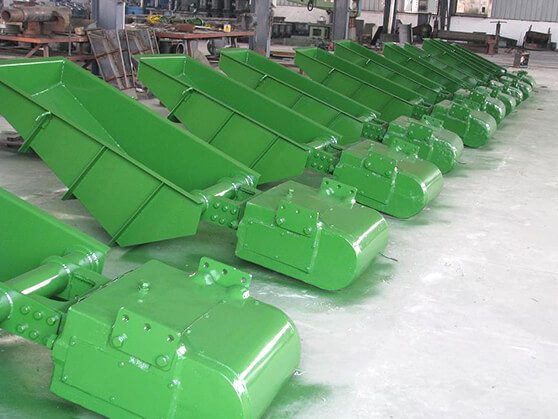En el vertiginoso mundo de la automatización industrial, vibratory feeders stand as unsung heroes. These unassuming devices deliver unmatched reliability in material handling, enabling everything from microchip assembly lines to mining operations. This article dives deep into their workings, types, applications, and how to optimize them for your needs—combining technical depth with practical insights.
1. What Is a Vibratory Feeder?
A vibratory feeder uses controlled vibrations to move bulk materials along a predefined path. Unlike conveyor belts, which rely on friction, vibratory feeders leverage elliptical or linear oscillations to “hop” materials forward. This method ensures gentle handling, precise control, and compatibility with fragile or irregularly shaped items like pharmaceuticals, electronics, or food products.
Core Purpose: Automate feeding, sorting, screening, and conveying tasks while minimizing human intervention and material damage.
2. How Vibratory Feeders Work: The Physics Behind the Motion
The magic lies in resonance dynamics. Here’s a breakdown:
– Drive Mechanism:
– Electromagnetic Drives: Use AC current to generate magnetic pulses, vibrating a spring-mounted tray at high frequencies (50–60 Hz). Ideal for fine control in packaging or pharmaceutical settings.
– Electromechanical Drives: Employ unbalanced motors/weights to create centrifugal force. Better for heavy-duty tasks like mining or metalworking (frequencies: 15–25 Hz).
– Motion Amplification: Springs (helical or leaf) amplify small vibrations into larger tray movements. The angle of these springs dictates material flow direction—adjustable for speed and spread.
– Material Flow: As the tray vibrates, particles “bounce” forward in micro-hops, propelled by inertia. This prevents sliding friction, reducing wear and heat buildup.
3. Types of Vibratory Feeders
Selecting the right type maximizes efficiency:
| Tipo | Mecanismo | Lo mejor para |
|---|---|---|
| Linear Feeders | Straight-path vibration | Conveying bulk materials between processes |
| Bowl Feeders | Spiral track inside a bowl | Precision orientation of small parts (screws, caps) |
| Tubular Feeders | Enclosed vibrating tube | Dusty or hazardous environments |
| Screening Feeders | Integrated mesh/screens | Sorting particles by size (aggregate, grains) |
Specialized Designs:
– Grizzly Feeders: Heavy-duty screens for mining, filtering oversized rocks.
– Deflection Feeders: Use air jets or mechanical arms to reject defective parts mid-feed.
4. Top Industrial Applications
Vibratory feeders are indispensable across sectors:
– Productos farmacéuticos: Gentle handling of pills, capsules; integrated metal detection.
– Procesado de alimentos: FDA-compliant designs for nuts, grains, or candy; anti-microbial coatings.
– Electrónica: Precision placement of microchips, connectors, and SMD components.
– Mining & Quarrying: Pre-screening ores with capacities up to 3,000 tons/hour.
– Automoción: Feeding screws, bolts, and bearings into assembly robots at 200+ parts/minute.
Real-World Impact: Automotive giants like Toyota save 30% in labor costs using vibratory systems integrated with AI-guided robotic arms.
5. Key Benefits: Why Vibratory Feeders Dominate Automation
- Control de precisión: Tune amplitude/frequency for exact feed rates (±2% accuracy).
- Bajo mantenimiento: No gears, belts, or complex parts; lifetime often exceeds 10 years.
- Eficiencia energética: Vibratory drives consume 50–70% less power than conveyors.
- Escalabilidad: From benchtop lab units to 20-meter industrial feeders.
- Hygiene & Safety: Fully enclosed designs prevent contamination; ATEX-certified models for explosive dust.
6. Critical Selection Criteria
Avoid costly mistakes with these factors:
| Factor | Key Considerations |
|---|---|
| Material Properties | Size, weight, moisture (sticky powders need anti-adhesion coatings like PTFE) |
| Rendimiento | Required feed rate (e.g., 10 kg/min vs. 2 tons/hour) |
| Medio ambiente | Temperature extremes (e.g., cryogenic feeds require stainless steel) |
| Integration | Compatibility with existing PLCs, sensors (e.g., Siemens, Rockwell controls) |
| Regulatory Needs | FDA, EU Machinery Directive, or ISO 9001 compliance |
7. Troubleshooting Common Issues
Quick fixes for persistent problems:
– Material Sticking? → Apply nano-coatings or air blasts; reduce humidity.
– Inconsistent Flow? → Calibrate drive settings; check for worn springs or motor imbalance.
– Noise/Vibration? → Isolate the feeder with rubber mounts; inspect fasteners.
– Jamming? → Optimize tray angle; install deflection paddles for tangled parts.
Consejo profesional: Use predictive maintenance tools like vibration sensors to detect imbalances early.
8. Future Trends & Innovations
- Smart Feeders: IoT sensors monitor material flow, temperature, and wear—predicting failures via cloud analytics.
- AI Optimization: Machine learning algorithms auto-adjust settings for variable materials (e.g., switching from granules to powder).
- Sustainable Designs: Recycled composite trays; regenerative drives converting vibration into stored energy.
- Sistemas híbridos: Combined with robotic vision for real-time sorting by color, shape, or defects.

9. Conclusion: The Engine of Modern Automation
Vibratory feeders are more than material movers—they enable the precision, speed, and reliability that define Industry 4.0. From assembling life-saving medical devices to filtering precious ores, their versatility is unmatched. By understanding their mechanics and tailoring them to your needs, you can slash costs, boost throughput, and future-proof production lines.
As automation surges, vibratory feeders will evolve from simple tools into intelligent subsystems. For engineers and plant managers alike, mastering these systems isn’t optional; it’s essential for competitive advantage.

